| The CAPABILITY Procedure |
Example 5.22 Estimating Parameters from Lognormal Plots
This example, which is a continuation of Example 5.21, demonstrates techniques for estimating the shape parameter, location and scale parameters, and theoretical percentiles for a lognormal distribution.
Three-Parameter Lognormal Plots
[See CAPQQ2 in the SAS/QC Sample Library]The three-parameter lognormal distribution depends on a threshold parameter  , a scale parameter
, a scale parameter  , and a shape parameter
, and a shape parameter  . You can estimate
. You can estimate  from a series of lognormal Q-Q plots with different values of
from a series of lognormal Q-Q plots with different values of  . The estimate is the value of
. The estimate is the value of  that linearizes the point pattern. You can then estimate the threshold and scale parameters from the intercept and slope of the point pattern. The following statements create the series of plots in Output 5.22.1 through Output 5.22.3 for
that linearizes the point pattern. You can then estimate the threshold and scale parameters from the intercept and slope of the point pattern. The following statements create the series of plots in Output 5.22.1 through Output 5.22.3 for  values of 0.2, 0.5, and 0.8:
values of 0.2, 0.5, and 0.8:
symbol v=plus;
title 'Lognormal Q-Q Plot for Diameters';
proc capability data=Measures noprint;
qqplot Diameter / lognormal(sigma=0.2 0.5 0.8)
square;
run;
 =0.2)
=0.2)
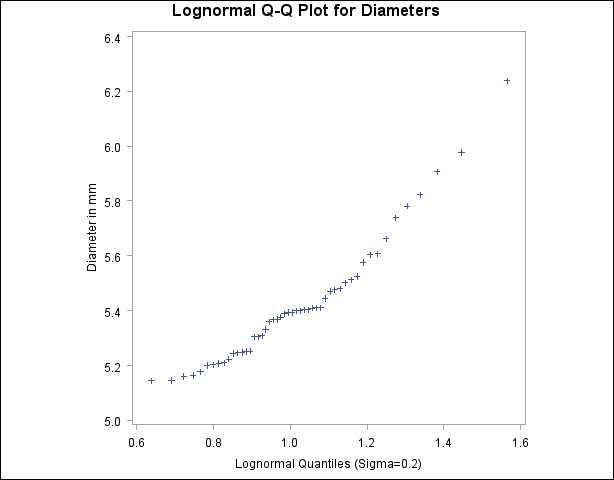
 =0.5)
=0.5)
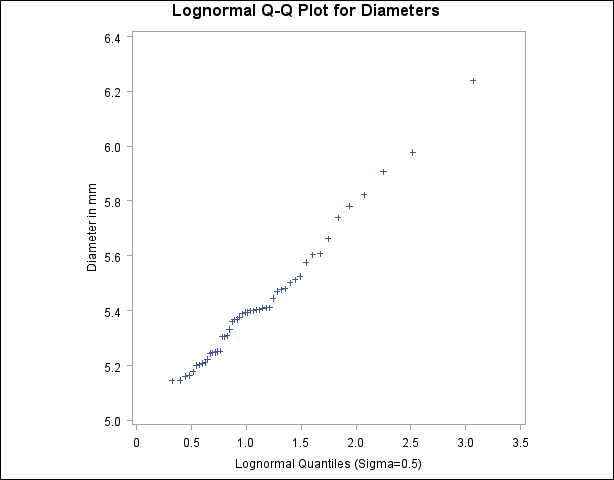
 =0.8)
=0.8)
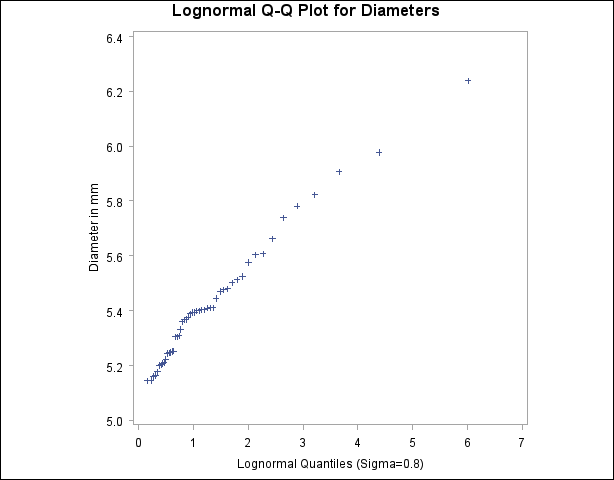
Note:You must specify a value for the shape parameter  for a lognormal Q-Q plot with the SIGMA= option or its alias, the SHAPE= option.
for a lognormal Q-Q plot with the SIGMA= option or its alias, the SHAPE= option.
The plot in Output 5.22.2 displays the most linear point pattern, indicating that the lognormal distribution with  provides a reasonable fit for the data distribution.
provides a reasonable fit for the data distribution.
Data with this particular lognormal distribution have the density function

The points in the plot fall on or near the line with intercept  and slope
and slope  . Based on Output 5.22.2,
. Based on Output 5.22.2,  and
and  , giving
, giving  .
.
Estimating Percentiles
[See CAPQQ2 in the SAS/QC Sample Library]You can use a Q-Q plot to estimate percentiles such as the  th percentile of the lognormal distribution.1
th percentile of the lognormal distribution.1
The point pattern in Output 5.22.2 has a slope of approximately 0.39 and an intercept of 5. The following statements reproduce this plot, adding a lognormal reference line with this slope and intercept.
ods graphics on;
title 'Lognormal Q-Q Plot for Diameters';
proc capability data=Measures noprint;
qqplot Diameter / lognormal(sigma=0.5 theta=5 slope=0.39)
pctlaxis(grid)
vref = 5.8 5.9 6.0;
run;
ods graphics off;
The ODS GRAPHICS ON statement specified before the PROC CAPABILITY statement enables ODS Graphics, so the Q-Q plot is created using ODS Graphics instead of traditional graphics. The result is shown in Output 5.22.4.
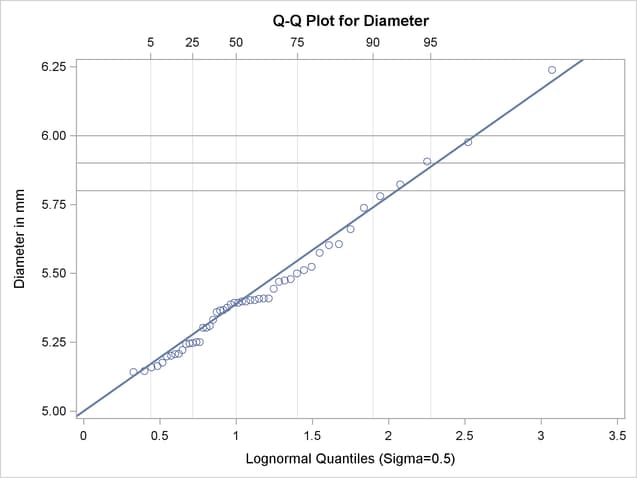
The PCTLAXIS option labels the major percentiles, and the GRID option draws percentile axis reference lines. The  th percentile is 5.9, since the intersection of the distribution reference line and the
th percentile is 5.9, since the intersection of the distribution reference line and the  th reference line occurs at this value on the vertical axis.
th reference line occurs at this value on the vertical axis.
Alternatively, you can compute this percentile from the estimated lognormal parameters. The  th percentile of the lognormal distribution is
th percentile of the lognormal distribution is
 |
where  is the inverse cumulative standard normal distribution. Consequently,
is the inverse cumulative standard normal distribution. Consequently,
 |
Two-Parameter Lognormal Plots
[See CAPQQ2 in the SAS/QC Sample Library]If a known threshold parameter is available, you can construct a two-parameter lognormal Q-Q plot by subtracting the threshold from the data and requesting a normal Q-Q plot. The following statements create this plot for Diameter, assuming a known threshold of five:
data Measures; set Measures; Logdiam=log(Diameter-5); label Logdiam='log(Diameter-5)'; run;
symbol v=plus;
title 'Two-Parameter Lognormal Q-Q Plot for Diameters';
proc capability data=Measures noprint;
qqplot Logdiam / normal(mu=est sigma=est)
square;
run;
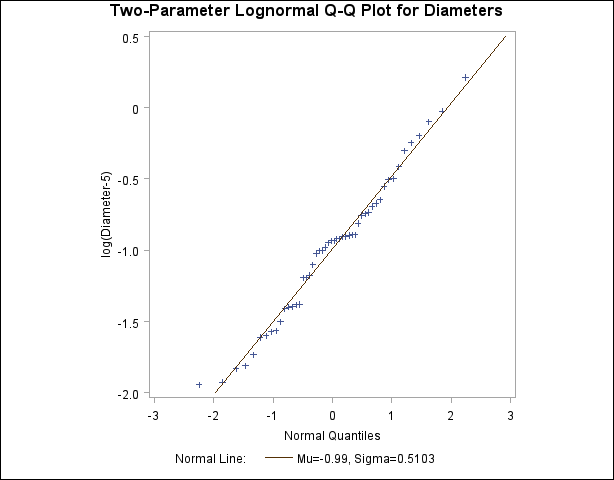
Because the point pattern in Output 5.22.5 is linear, you can estimate the lognormal parameters  and
and  as the normal plot estimates of
as the normal plot estimates of  and
and  , which are
, which are  and
and  . These values correspond to the previous estimates of
. These values correspond to the previous estimates of  for
for  and
and  for
for  .
.
Copyright © SAS Institute, Inc. All Rights Reserved.